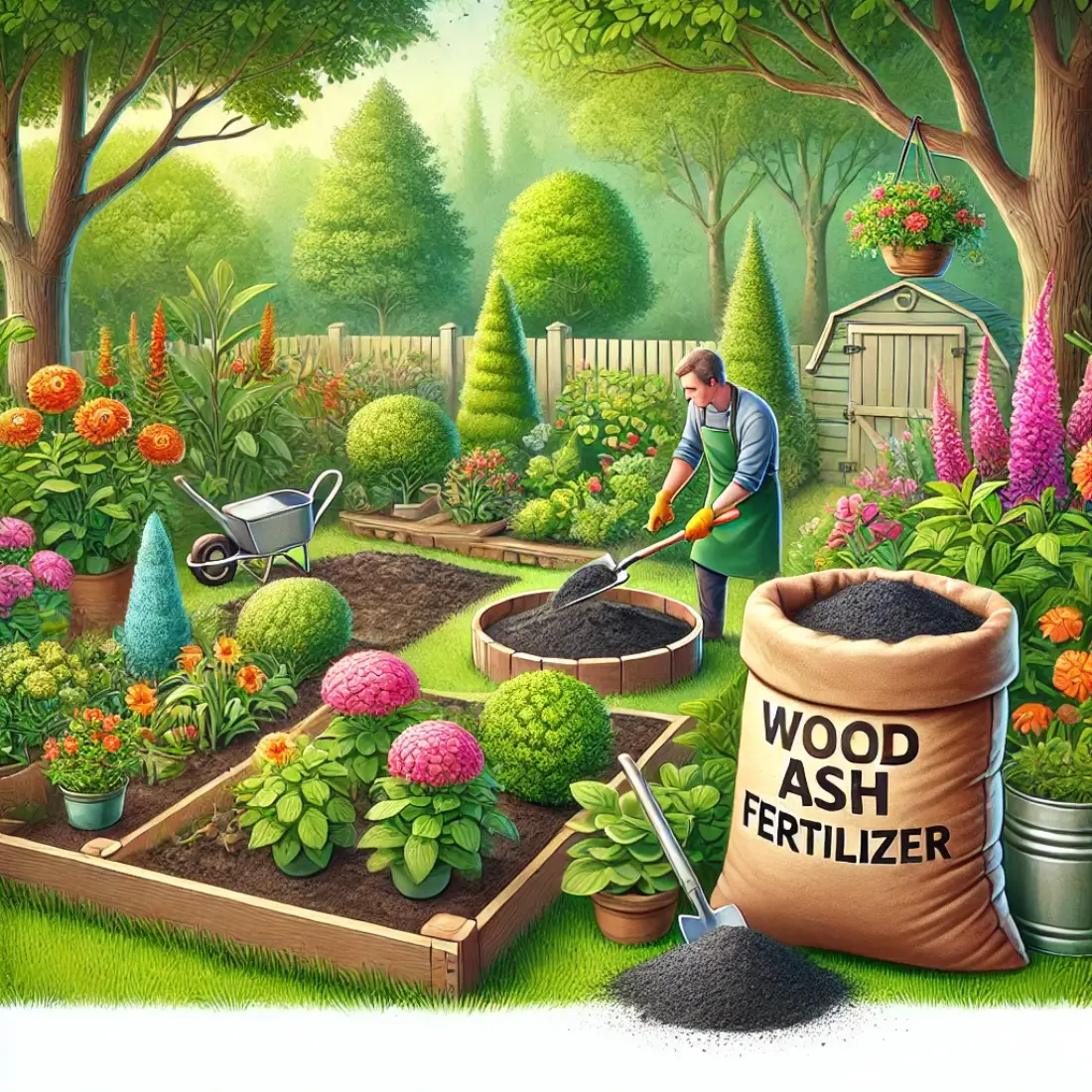Wood ash, a byproduct of burning wood, is often discarded without realizing its potential benefits for gardening. Using wood ash in the garden can significantly improve soil health and plant vitality.
This natural resource, rich in essential nutrients, offers a sustainable solution for gardeners seeking to enhance their soil’s quality and reduce their reliance on chemical fertilizers. Wood ash can improve soil pH.
- Acts as a natural fertilizer.
- Helps in pest control.
- Enhances plant health.
Understanding Wood Ash
Wood ash is the fine, powdery residue left after the complete combustion of wood. Composed primarily of minerals, it contains elements such as calcium, potassium, magnesium, and phosphorus. These nutrients are beneficial for plant growth, making wood ash an excellent addition to garden soil.
The composition of wood ash can vary depending on the type of wood burned. Hardwoods like oak and maple generally produce more ash and contain higher nutrient levels compared to softwoods like pine and fir. Additionally, the burning temperature can affect the ash’s composition; higher temperatures typically result in ash with fewer unburned particles and higher mineral content.
A key characteristic of wood ash is its alkalinity, with a pH level ranging between 9 and 11. This makes it useful for raising the pH of acidic soils, creating a more favorable environment for many plants. However, it’s crucial to avoid using wood ash on plants that prefer acidic conditions, such as blueberries and rhododendrons.
Unlike coal ash, which contains harmful heavy metals, wood ash is generally safe for garden use. However, it’s important to use it correctly and in moderation to avoid potential issues such as nutrient imbalances and salt buildup in the soil.
Benefits of Using Wood Ash in the Garden
Using wood ash in the garden offers numerous advantages, enhancing soil quality and plant health through its nutrient content and pH-regulating properties.
Soil pH Regulation
Wood ash is highly alkaline, with a pH level between 9 and 11, making it an excellent amendment for raising the pH of acidic soils. Many plants thrive in slightly alkaline conditions, and wood ash can create a more favorable environment for their growth. By neutralizing soil acidity, wood ash helps improve nutrient availability and overall soil health.
Natural Fertilizer
Wood ash contains essential nutrients such as potassium, calcium, and magnesium, which are vital for plant growth. Potassium, in particular, is crucial for root development, flowering, and fruiting.
Wood ash also provides trace elements like iron, zinc, and copper, contributing to a well-rounded nutrient profile. This makes wood ash an effective and sustainable alternative to commercial fertilizers.
Pest Control
Wood ash can act as a natural pest deterrent. Sprinkling wood ash around plants helps repel slugs, snails, and certain insect pests. The alkaline nature of ash irritates these pests, keeping them away from your garden without the need for chemical pesticides.
Improving Soil Structure
Adding wood ash to garden soil can enhance its structure by improving drainage and aeration. This helps roots grow more effectively and access nutrients and water more easily. Well-structured soil supports healthy plant growth and resilience against environmental stresses.
Composting Aid
Wood ash can be a valuable addition to compost piles. It helps balance the pH of compost, speeding up the decomposition process and improving the quality of the finished compost. When used in moderation, wood ash can enhance the nutrient content of compost, making it a more effective soil amendment.
How to Use Wood Ash in the Garden
Using wood ash in the garden can provide numerous benefits, but it’s essential to apply it correctly to maximize its effectiveness and avoid potential problems.
Before applying wood ash, conduct a soil test to determine your soil’s pH. Wood ash is alkaline and will raise the soil pH, making it suitable for acidic soils but not for those already alkaline.
Application Methods
Direct Application: Scatter wood ash directly onto the soil. Lightly rake it in to ensure it mixes well with the top layer. This method is ideal for garden beds and around plants that benefit from higher pH and added nutrients.
Mixing with Compost: Add wood ash to your compost pile. It helps balance the pH of compost and speeds up the decomposition process. However, use it sparingly – no more than one cup per wheelbarrow of compost – to avoid creating overly alkaline compost.
Side Dressing for Specific Plants: Apply wood ash as a side dressing around specific plants, like tomatoes and root vegetables. Sprinkle it around the base of the plants and gently mix it into the soil.
Dosage and Frequency
Use wood ash sparingly to prevent nutrient imbalances and soil alkalinity issues. As a general rule, apply about 5 to 10 pounds of wood ash per 1,000 square feet of garden space annually. Adjust this amount based on your soil test results and the specific needs of your plants.
Seasonal Considerations
Apply wood ash in the fall or winter to allow time for it to interact with the soil before the growing season begins. Avoid applying it during the planting or growing season to prevent potential plant damage.
Safety Precautions
Handle wood ash with care. Wear gloves and a mask to avoid skin irritation and inhalation of fine particles. Store wood ash in a dry, covered container to prevent it from getting wet and clumping.
Potential Risks and Mitigation
- Over-application Risks: Overuse can lead to soil pH imbalances and nutrient deficiencies.
- Salt Buildup: Excessive wood ash can increase soil salinity, affecting plant health. Apply in moderation and monitor soil conditions regularly.
Best Plants for Wood Ash Application
Using wood ash in the garden can benefit a variety of plants by providing essential nutrients and improving soil pH. However, it’s important to apply wood ash to plants that thrive in slightly alkaline conditions.
Vegetables
Tomatoes: Tomatoes benefit from the potassium in wood ash, which promotes strong root development and enhances fruit quality. Sprinkle a small amount of wood ash around the base of the plants and mix it into the soil.
Carrots: Carrots thrive in slightly alkaline soil. Apply wood ash sparingly to help improve soil structure and provide essential nutrients.
Beets: Like carrots, beets prefer soil with a higher pH. Wood ash can help improve the soil conditions and provide the potassium beets need for healthy growth.
Flowers
Lilies: Lilies enjoy alkaline soil and benefit from the added calcium and potassium in wood ash. Apply a light dusting of wood ash around the plants to promote vigorous growth and vibrant blooms.
Peonies: Peonies prefer soil that is not too acidic. Wood ash can help raise the soil pH and provide essential nutrients, resulting in stronger plants and more abundant flowers.
Roses: Roses benefit from the potassium and phosphorus in wood ash, which promote healthy root development and flowering. Apply wood ash around the base of rose bushes and gently mix it into the soil.
Fruit Trees
Apple Trees: Apple trees thrive in soil with a balanced pH. Wood ash can help maintain the right soil conditions and provide essential nutrients for fruit development. Apply wood ash around the drip line of the tree and work it into the soil.
Cherry Trees: Like apple trees, cherry trees benefit from the potassium and calcium in wood ash. Apply it around the base of the tree to improve soil quality and support healthy growth.
Lawns and Grasses
Applying wood ash to lawns can help improve soil structure, enhance grass growth, and increase resistance to pests. Use it sparingly and evenly distribute it to avoid over-alkalizing the soil.
Potential Drawbacks and How to Avoid Them
Using wood ash in the garden offers numerous benefits, but it’s essential to be aware of potential drawbacks to avoid damaging your plants and soil.
Over-application Risks
Applying too much wood ash can lead to an excessively high soil pH, making the soil too alkaline for many plants. This can result in nutrient imbalances, as certain nutrients become less available to plants in overly alkaline conditions. Symptoms of over-application include yellowing leaves and stunted growth.
How to Avoid: Conduct a soil test before applying wood ash to determine the existing pH and nutrient levels. Apply wood ash sparingly, following recommended amounts (generally 5 to 10 pounds per 1,000 square feet annually). Regularly monitor soil pH and adjust usage as needed.
Salt Buildup
Wood ash contains soluble salts, which can accumulate in the soil over time. High salt concentrations can harm plants by affecting their ability to absorb water and nutrients, leading to symptoms such as leaf burn and reduced growth.
How to Avoid: Apply wood ash in moderation and avoid using it on salt-sensitive plants. Ensure proper irrigation to help leach excess salts from the soil. Rotate the application areas each season to prevent salt buildup in one location.
Compatibility with Certain Plants
Not all plants thrive in alkaline conditions. Acid-loving plants, such as blueberries, azaleas, and rhododendrons, can suffer from nutrient deficiencies and poor growth if exposed to wood ash.
How to Avoid: Identify the pH preferences of your plants before applying wood ash. Use alternative soil amendments for acid-loving plants and keep wood ash away from these areas.
FAQs about Wood Ash
Is wood ash safe for all types of gardens?
Wood ash is generally safe for most gardens, but it is important to use it correctly. It should not be used on acid-loving plants like blueberries, azaleas, and rhododendrons, as it can raise the soil pH too much for these plants to thrive.
How often should I apply wood ash to my garden?
Wood ash should be applied sparingly, typically once a year. The recommended amount is about 5 to 10 pounds per 1,000 square feet of garden space. Always test your soil pH before application to avoid over-alkalizing the soil.
Can wood ash be used in potted plants?
Yes, wood ash can be used in potted plants, but in very small amounts. Mix a small amount into the potting soil to provide nutrients. Be cautious with the dosage to avoid over-alkalizing the soil in the pot.
What is the best way to store wood ash?
Store wood ash in a dry, covered container to keep it from absorbing moisture. This prevents it from clumping and makes it easier to handle and apply when needed.
Does wood ash attract pests?
No, wood ash does not attract pests. In fact, it can help deter certain pests like slugs and snails due to its alkaline nature. Sprinkling a thin layer around plants can create a barrier that pests are less likely to cross.
How does wood ash affect soil pH?
Wood ash is highly alkaline and can raise the pH of acidic soils. This can create a more favorable environment for many plants that prefer neutral to slightly alkaline soil conditions. Always test soil pH before application.
Can I use wood ash from any type of wood?
Hardwoods like oak and maple produce ash that is richer in nutrients compared to softwoods like pine. Avoid using ash from treated or painted wood, as it may contain harmful chemicals that can be detrimental to your garden.
How does wood ash compare to commercial fertilizers?
Wood ash is a natural source of essential nutrients like potassium, calcium, and magnesium. While it may not provide as concentrated a nutrient boost as commercial fertilizers, it offers a sustainable and eco-friendly alternative, enriching the soil over time.
Can I mix wood ash with other soil amendments?
Yes, wood ash can be mixed with other soil amendments, such as compost, to balance its alkalinity and enhance the nutrient content of the soil. This combination can improve soil structure and fertility.
What are the signs of too much wood ash in the soil?
Signs of over-application include yellowing leaves, stunted growth, and poor plant health. This can happen due to excessive soil alkalinity or salt buildup. If you notice these symptoms, stop applying wood ash and consider soil testing to rectify the issue.











